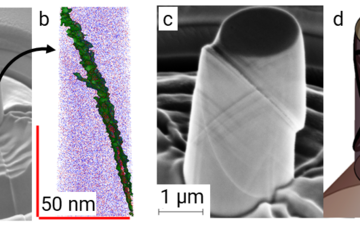All genres
101.
Journal Article
Characterizing solute hydrogen and hydrides in pure and alloyed titanium at the atomic scale. Acta Materialia 150, pp. 273 - 280 (2018)
102.
Journal Article
Hydrogen embrittlement of an interstitial equimolar high-entropy alloy. Corrosion Science 136, pp. 403 - 408 (2018)
103.
Journal Article
Competition between formation of carbides and reversed austenite during tempering of a medium-manganese steel studied by thermodynamic-kinetic simulations and atom probe tomography. Acta Materialia 147, pp. 165 - 175 (2018)
104.
Journal Article
Understanding hot vs. Cold rolled medium manganese steel deformation behavior using in situ microscopic digital image correlation. Materials Science Forum 941, pp. 198 - 205 (2018)
105.
Journal Article
Interfaces and defect composition at the near-atomic scale through atom probe tomography investigations. Journal of Materials Research 33 (23), pp. 4018 - 4030 (2018)
106.
Journal Article
Strengthening and strain hardening mechanisms in a precipitation-hardened high-Mn lightweight steel. Acta Materialia 140, pp. 258 - 273 (2017)
107.
Journal Article
Development of damage-resistant dual-phase steels. Chernye Metally 57 (9), pp. 40 - 41 (2017)
108.
Journal Article
Hydrogen effects on microstructural evolution and passive film characteristics of a duplex stainless steel. Electrochemistry Communucations 79, pp. 28 - 32 (2017)
109.
Journal Article
Ultrastrong steel via minimal lattice misfit and high-density nanoprecipitation. Nature 544 (7651), pp. 460 - 464 (2017)
110.
Journal Article
Hydrogen-assisted failure in Ni-based superalloy 718 studied under in situ hydrogen charging: The role of localized deformation in crack propagation. Acta Materialia 128, pp. 365 - 374 (2017)
111.
Journal Article
Bone-like crack resistance in hierarchical metastable nanolaminate steels. Science 355 (6329), pp. 1055 - 1057 (2017)
112.
Journal Article
Confined chemical and structural states at dislocations in Fe–9wt%Mn steels: A correlative TEM-atom probe study combined with multiscale modelling. Acta Materialia 124, pp. 305 - 315 (2017)
113.
Journal Article
Superplasticity in a lean Fe–Mn–Al steel. Nature Communications 8, 751, pp. 1 - 6 (2017)
114.
Journal Article
The effects of prior austenite grain boundaries and microstructural morphology on the impact toughness of intercritically annealed medium Mn steel. Acta Materialia 122, pp. 199 - 206 (2017)
115.
Journal Article
Entwicklung schadenstoleranter Dualphasenstähle. Stahl und Eisen 137, p. 88 - 88 (2017)
116.
Journal Article
Strain hardening by dynamic slip band refinement in a high-Mn lightweight steel. Acta Materialia 116, pp. 188 - 199 (2016)
117.
Journal Article
Spectral TRIP enables ductile 1.1 GPa martensite. Acta Materialia 111, pp. 262 - 272 (2016)
118.
Journal Article
Multi-scale and spatially resolved hydrogen mapping in a Ni–Nb model alloy reveals the role of the δ phase in hydrogen embrittlement of alloy 718. Acta Materialia 109, pp. 69 - 81 (2016)
119.
Journal Article
Effect of intercritical deformation on microstructure and mechanical properties of a low-silicon aluminum-added hot-rolled directly quenched and partitioned steel. Materials Science and Engineering A: Structural Materials Properties Microstructure and Processing 656, pp. 200 - 215 (2016)
120.
Journal Article
Atomic scale investigation of non-equilibrium segregation of boron in a quenched Mo-free martensitic steel. Ultramicroscopy 159, pp. 240 - 247 (2015)











